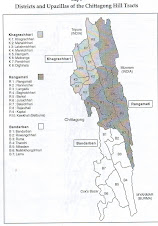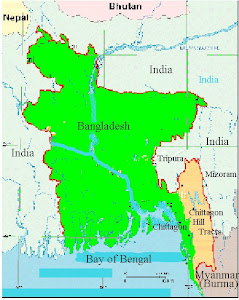http://www.iwgia.org/sw28280.asp
The majority of Bangladesh’s 143.3 million people are Bengalis, and approximately 2.5 million are indigenous peoples belonging to 45 different ethnic groups. These peoples are concentrated
in the north, and in the Chittagong Hill Tracts (CHT) in the south-east of the country. In the CHT, the indigenous peoples are commonly known as Jummas for their common practice of swidden cultivation (crop rotation agriculture) locally known as jum. There is no constitutional recognition of the indigenous peoples of Bangladesh. They are only referred to as “backward segments of the population”.
Indigenous peoples remain among the most persecuted of all minorities, facing discrimination not only on the basis of their religion and ethnicity but also because of their indigenous identity and their socio-economic status. In the CHT, the indigenous peoples took up arms in defence of their rights. In December 1997, the 25-year-long civil war ended with a Peace Accord between the Government of Bangladesh and the Parbattya Chattagram Jana Samhati Samiti (PCJSS, United People’s Party), which led the resistance movement. The Accord recognises the Chittagong Hill Tracts as a “tribal inhabited” region, its traditional governance system and the role of its chiefs, and it provides building blocks for indigenous autonomy.
(From The Indigenous World 2008)
skip to main |
skip to sidebar


Map of Bangladesh

CHTs is number one Milliary zone in the world


Ministry of Chittagong Hill Tracts Affairs
The United Nation
The IJPMNA
This page provides information of the minority Indigenous Jumma Peoples in Chittagong Hill Tracts (CHTs) Bangladesh.
Contact with this please write:-ijpnusa@yahoo.com
Contact with this please write:-ijpnusa@yahoo.com
About Us
Location of Jummaland

Jumma Videos
- The BANDARBAN SADAR
- The Rowangchari
- The Ruma
- The Lama
- The Thanchi
- The Alikadom
- The Naikhkhongchari
- The RANGAMATI SADAR
- The Baghaichari
- The Langudu
- The Nanyachar
- The Barkal
- The Jurachari
- The Bilaichari
- The Kaptai
- The Rajsthali
- The Kawkhali
- The KHAGRACHARI SADAR
- The Manikchari
- The Laksmichari
- The Mahalchari
- The Matiranga
- The Ramgarh
- The Dighinala
- The Panchari
Audio & Video
Jumma Natok (Drama)
International Support
Educational Institution
Religious Organization
Buddhist Studies

Map of Bangladesh
Mission of Bangladesh
About Bangladesh
Bangali Audio Songs
Bengali News

CHTs is number one Milliary zone in the world
Online Audios
Refugee in Homeland

Jumma Picture

Blog Archive
About Me
- The Indigenous Jumma Peoples Movement in North America
- The Chittagong Hill Tracts (CHT) region comprises three districts: Banderban , Khagrachari and Rangamati. The districts comprise seven main valleys formed by the Feni, Karnafuli, Chengi, Myani, Kassalong, Sangu and Matamuhuri rivers aid their tributaries and numerous hills, ravines and cliffs covered with dense vegetation, which are in complete contrast to most other districts of Bangladesh, which consist mainly of alluvial lands. Geographically the CHT can be divided into two broad ecological zones: (a) hill valley, (b) agricultural plains. It is surrounded by the Indian states of Tripura on the north and Mizoram on the east, Myanmar on the south and east and Chittagong district on the west.
